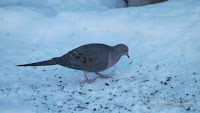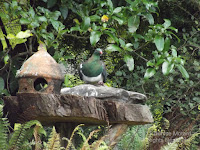BIRD FEEDING
Bird Feeding is a very ancient human activity, dating back several centuries. It is now a popular year-round mainstream activity and has become a good business too. Bird feed is sold in a variety of stores, where sometimes a part of the profits from sales will go to bird conservation organizations. Bird seed can be bought in large quantities, just like dog food. There are also all kinds of models of bird feeders available, including plans to build our own, depending on the type of food and the bird species, and on the person’s budget. Some common bird feeders are described below.
There are some forms on 'indirect' feeding of birds by leaving food scraps available for them, whether on picnic table (see photo below), at garbage dumps or at fishing ports (photo below).
There are also direct forms of FEEDING BIRDS TO ATTRACT THEM FOR PHOTOS, such as with Birding Tours for Tourists in various countries. Here is one example below, off Kaikoura Peninsula in New Zealand:
THE SUET LOG
This bird feeder is a log with drilled holes in which beef suet is pressed. It is easy – and cheap – to make. Other feeds such as peanut butter can be used but beef suet is a less processed type of feed. The log is than hung on either a rope or from a branch. Due to the perishable nature of this type of feed, it can only be used in the winter or cold weather during the ‘shoulder’ seasons. A variation on the suet feeder is the empty plastic netting bag used for onions or oranges. It is filled with chunks of beef suet and hung the same way as the log.
THE SEED FEEDER
This is where there’s the most variety offered on the market. Feeding birds with seed however needs to be done in a careful way to avoid problems for the birds being fed. Examples: risk of contamination from molds if the feeder is not cleaned regularly and if moisture gathers with the seeds; increased risk of predation by birds of prey or domestic animals around the feeder; risk of collision in windows if the feeder is close; competition from undesired species such as squirrels or raccoons, for example.
FEEDING BY HAND
Feeding the birds by throwing them seeds or bread crumbs on the ground or feeding them right from our hand is deeply rooted in human civilization. Whether it is feeding the pigeons at Trafalgar Square or being the Bird Woman in Mary Poppins, humans thoroughly enjoy feeding the birds.
THE NECTAR FEEDER
In PEI this type of feeder is for the ruby-throated hummingbird. Island Nature Trust has a brochure on how to properly feed this bird. The basic nectar recipe is easy to do at home: one part of white sugar for four parts of water, boiled and cooled. No dyes or artificial sweeteners.
Another type of nectar feeder is shown below, for the Tui bird (Prosthemadera novaeseelandiae). It is a horizontal bamboo log filled with a specially-made syrup. Other, more expensive, models exist too.
WATER SOURCES Birds drink water from any available source in their environment. Sometimes the water they’re drinking doesn’t look very clean – do they get sick from it? Many people will add a water source for birds in their gardens or back yards, such as a bird bath, which birds also use for drinking. It is important to keep this water clean, particularly on hot days. Below is a drinking container for birds in a New Zealand garden, Te Kainga Marire. It is rustic – a naturally carved stone installed on top of a ‘slice’ of lumber about 2.5 meters (8 feet) from the ground.
TO FEED OR NOT TO FEED? That is an important question.
Providing artificial feeding to wild birds comes with a number of questions.
Wildlife government agencies are unanimous on the recommendation of NOT feeding wildlife, as it makes these animals dependent on food handouts among other problems. Birds ARE wildlife, so why are we feeding them? Is it really for their well-being or for our own satisfaction, for example to get good photos and videos of them?
While wild birds feed on artificial food handouts, they are not feeding on their natural sources of food in their environment. This can create problems, such as when seed eaters rely on seed feeders rather than 'seeding out' weeds in the fields. What is the impact of this artificial seed feeding of wild birds on the proliferation of weeds in fields?
The same could be said about suet and peanut butter feeders that attract woodpeckers for example. Woodpeckers forage for insects on trees, keeping pests in check. What is the impact from artificially feeding them on their natural foraging sources on trees?
Some types of bird seeds sold in countries such as Canada are not indigenous, i.e. they are from plants native to tropical regions. What is the impact on Canadian birds' long-term health from artificially feeding them those types of seeds? What is the impact on hummingbirds health from feeding them with 'nectar' made from white sugar and water?
Bird seed does not all stay on the feeder; what is not eaten falls to the ground, where birds will eat those seeds. Once on the ground however, these birds might become more vulnerable to predators. Seeds on the ground are also attracting undesirable species such as rodents. And since some conservationists urge people to keep their cats indoors, this might lead to an increase in rodent infestation.
What is the impact of artificial feeding on the migration patterns of birds? Does it influence the timing when they leave south for the winter? The timing of migration is related to the availability of natural food sources along the migratory route, for example some seeds will ripen within a certain time frame.
If we really want to help wild birds, focusing on habitat conservation should be our priority.
There are some forms on 'indirect' feeding of birds by leaving food scraps available for them, whether on picnic table (see photo below), at garbage dumps or at fishing ports (photo below).
 |
| Red-billed gulls fighting over food waste, NZ |
 |
| Brown pelican juvenile snatching a fish Aransas Bay, TX, by Jodi Arsenault |
 |
| Great blue heron helping itself directly from fish pail, by Jodi Arsenault |
There are also direct forms of FEEDING BIRDS TO ATTRACT THEM FOR PHOTOS, such as with Birding Tours for Tourists in various countries. Here is one example below, off Kaikoura Peninsula in New Zealand:
 |
| Wandering albatrosses, Southern giant petrels fighting over fish livers thrown from boat off Kaikoura, NZ |
This bird feeder is a log with drilled holes in which beef suet is pressed. It is easy – and cheap – to make. Other feeds such as peanut butter can be used but beef suet is a less processed type of feed. The log is than hung on either a rope or from a branch. Due to the perishable nature of this type of feed, it can only be used in the winter or cold weather during the ‘shoulder’ seasons. A variation on the suet feeder is the empty plastic netting bag used for onions or oranges. It is filled with chunks of beef suet and hung the same way as the log.
THE SEED FEEDER
This is where there’s the most variety offered on the market. Feeding birds with seed however needs to be done in a careful way to avoid problems for the birds being fed. Examples: risk of contamination from molds if the feeder is not cleaned regularly and if moisture gathers with the seeds; increased risk of predation by birds of prey or domestic animals around the feeder; risk of collision in windows if the feeder is close; competition from undesired species such as squirrels or raccoons, for example.
 |
| Mourning dove eats sunflower seeds from seed feeder hung above |
Feeding the birds by throwing them seeds or bread crumbs on the ground or feeding them right from our hand is deeply rooted in human civilization. Whether it is feeding the pigeons at Trafalgar Square or being the Bird Woman in Mary Poppins, humans thoroughly enjoy feeding the birds.
 |
| Hand feeding Superb starlings in Tanzania |
In PEI this type of feeder is for the ruby-throated hummingbird. Island Nature Trust has a brochure on how to properly feed this bird. The basic nectar recipe is easy to do at home: one part of white sugar for four parts of water, boiled and cooled. No dyes or artificial sweeteners.
 |
| Violet sabrewing, Costa Rica, Roberta Palmer |
WATER SOURCES Birds drink water from any available source in their environment. Sometimes the water they’re drinking doesn’t look very clean – do they get sick from it? Many people will add a water source for birds in their gardens or back yards, such as a bird bath, which birds also use for drinking. It is important to keep this water clean, particularly on hot days. Below is a drinking container for birds in a New Zealand garden, Te Kainga Marire. It is rustic – a naturally carved stone installed on top of a ‘slice’ of lumber about 2.5 meters (8 feet) from the ground.
 |
| New Zealand pigeon at stone water container |
Providing artificial feeding to wild birds comes with a number of questions.
Wildlife government agencies are unanimous on the recommendation of NOT feeding wildlife, as it makes these animals dependent on food handouts among other problems. Birds ARE wildlife, so why are we feeding them? Is it really for their well-being or for our own satisfaction, for example to get good photos and videos of them?
While wild birds feed on artificial food handouts, they are not feeding on their natural sources of food in their environment. This can create problems, such as when seed eaters rely on seed feeders rather than 'seeding out' weeds in the fields. What is the impact of this artificial seed feeding of wild birds on the proliferation of weeds in fields?
The same could be said about suet and peanut butter feeders that attract woodpeckers for example. Woodpeckers forage for insects on trees, keeping pests in check. What is the impact from artificially feeding them on their natural foraging sources on trees?
Some types of bird seeds sold in countries such as Canada are not indigenous, i.e. they are from plants native to tropical regions. What is the impact on Canadian birds' long-term health from artificially feeding them those types of seeds? What is the impact on hummingbirds health from feeding them with 'nectar' made from white sugar and water?
Bird seed does not all stay on the feeder; what is not eaten falls to the ground, where birds will eat those seeds. Once on the ground however, these birds might become more vulnerable to predators. Seeds on the ground are also attracting undesirable species such as rodents. And since some conservationists urge people to keep their cats indoors, this might lead to an increase in rodent infestation.
What is the impact of artificial feeding on the migration patterns of birds? Does it influence the timing when they leave south for the winter? The timing of migration is related to the availability of natural food sources along the migratory route, for example some seeds will ripen within a certain time frame.
If we really want to help wild birds, focusing on habitat conservation should be our priority.